KATA-DORI IKKYO
Omote
Demonstrated and explained by Kanetsuka Sensei
Photos and text: Peter Megann
Graphics and typesetting: Graham and Laura Jones
Uke: Richard Martin
|
|

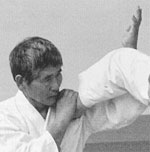
|
1 Suwari-waza
The particular benefit from suwari-waza ikkyo (and particularly from kata-dori) is that it enables us to concentrate on 'solid' contact with our partner and to learn correct ma-ai. The distance between you and your partner is very short: the contact is very direct. Don't hurry when you are studying this technique.
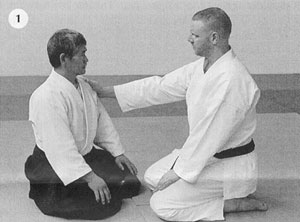 Photo 1: Both Tori and Uke start in seiza, Uke grasps Tori's left shoulder (with a view to controlling and attacking Tori) and is ready to pull (hence the omote version of this technique).
Photo 1: Both Tori and Uke start in seiza, Uke grasps Tori's left shoulder (with a view to controlling and attacking Tori) and is ready to pull (hence the omote version of this technique).
Photos 2a & 2b: Making atemi, Tori comes onto his toes (kiza) and moves off the line of attack, slightly to his left with his concentration remaining on Uke's centre. Tori's centre of gravity is low. Notice the movement of Tori's left arm. His hand is outstretched, the thumb turning down. Body and arm move to the left together. As Tori moves to his left his weight comes onto his left knee. The movement is essentially that of sokumen (to the side). Uke's position is now considerably weakened. Tori's ki or stream of energy is flowing up from his toes, through his knees and centre towards Uke's armpit or neck.
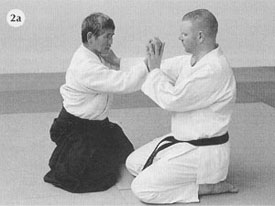

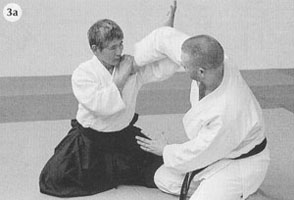
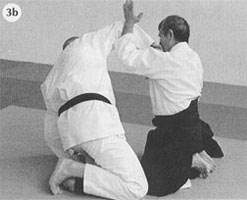
Photos 3a & 3b: Tori's left arm swings up in an arc to make contact with Uke's arm just above the elbow with his te-gatana (hand-blade*), while keeping his left elbow low. With his right hand Tori clamps Uke's gripping hand firmly against his shoulder with what we might call a nikyo grip. (Do not try to free yourself from your partner's grip). During this action Tori begins to shift his centre of gravity onto his left knee, without leaning to the side. Keeping his body low, Tori extends his left te-gatana further through Uke's elbow, while pressing his left shoulder against Uke's right hand. This movement comes very much from your centre, with a cutting feeling that engages the whole body, rather than a feeling of simply pushing with your hand. This action causes your partner to lose his balance as his elbow and shoulder come up, and if it is performed correctly you should need to use very little strength in your arms.
|
* The expression te-gatana is formed from two words; te ( ), hand, and
katana ( ), hand, and
katana ( ),
blade (the characters can also be read as shu and to and pronounced sh'to). However, for Japanese te means not just the hand alone but also the forearm. In this context the contact is made not with the hand but with the part of the ulna bone just below the wrist. ),
blade (the characters can also be read as shu and to and pronounced sh'to). However, for Japanese te means not just the hand alone but also the forearm. In this context the contact is made not with the hand but with the part of the ulna bone just below the wrist.
|
Photo 4: Tori slides his right knee a little forwards and shifts his centre of gravity onto this knee (this is like the reverse of the action shown in photos 2a and 2b).

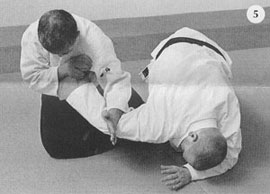
Photo 5: Tori starts to move his left knee and hip forwards across Uke's front, at the same time cutting down with his left arm. The result is that Uke is brought down in a semicircular movement around Tori's shoulder.
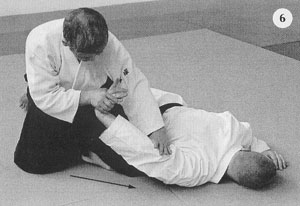 Photo 6: As Uke is brought down to the tatami, his grip on Tori's shoulder is relaxed. Now Tori grasps Uke's arm just above the elbow in the usual ikkyo manner. He is still holding Uke's right hand with the original nikyo grip. Tori slides his left knee towards Uke's armpit.
Photo 6: As Uke is brought down to the tatami, his grip on Tori's shoulder is relaxed. Now Tori grasps Uke's arm just above the elbow in the usual ikkyo manner. He is still holding Uke's right hand with the original nikyo grip. Tori slides his left knee towards Uke's armpit.
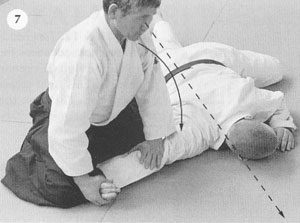 Photo 7: Tori finishes the technique in the same manner as with omote shomen-uchi ikkyo (from kosa-dori / ai-hanmi katate-dori). He moves Uke's arm to an angle of more than 90° from his body, ideally about 100-105°. Tori is silting up on his toes (in kiza), inclining slightly forwards, his back straight and his eyes looking towards the tatami several feet beyond Uke. His two knees and his ankles (drawn together) make a very solid triangle. With his right knee placed on the inside of his right wrist and his left knee close to Uke's armpit, his knees have a feeling of expanding in both directions. With relaxed shoulders and arms he shifts his weight, with a rocking feeling, onto Uke's elbow. This is essentially the same as the finish of the suwari-waza kokyu-ho exercise.
Photo 7: Tori finishes the technique in the same manner as with omote shomen-uchi ikkyo (from kosa-dori / ai-hanmi katate-dori). He moves Uke's arm to an angle of more than 90° from his body, ideally about 100-105°. Tori is silting up on his toes (in kiza), inclining slightly forwards, his back straight and his eyes looking towards the tatami several feet beyond Uke. His two knees and his ankles (drawn together) make a very solid triangle. With his right knee placed on the inside of his right wrist and his left knee close to Uke's armpit, his knees have a feeling of expanding in both directions. With relaxed shoulders and arms he shifts his weight, with a rocking feeling, onto Uke's elbow. This is essentially the same as the finish of the suwari-waza kokyu-ho exercise.
Learn how to move with your whole body; you must move like a pyramid. Don't lean forwards. The sokumen version of the technique shown here is the basic form. However if your partner pulls strongly, raise your hips (coming from seiza to kiza) and make a more direct ornate movement, driving your left knee forward (and moving with shikko), your loft knee and your left te-gatana working together.
2 Tachi-waza
Photos 8, 9a & 9b: Tori is in hidari gyaku-hanmi. As Uke takes Tori's left shoulder and pulls, Tori - keeping his body upright -lakes one step to the side, moving slightly forward and making atemi to Uke's face. (But don't advance too much to your partner's side, otherwise you will find yourself behind your partner and will not be able to apply the technique.) After making atemi Tori's right hand comes down Uke's arm in a kind of stroking motion to take Uke's fist and clamp it to his shoulder. (Keep your right elbow down as you do this.)
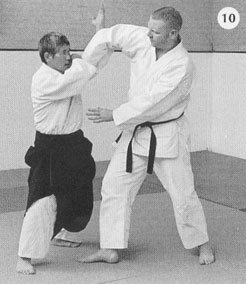 Photo 10: As Tori brings up his te-gatana to Uke's elbow, he lowers his centre of gravity and brings it strongly over his back (left) foot, (Again, don't grip your partner's elbow). Slash upwards with your te-gatana making contact with the part of your arm just below your wrist and keep your hand open and dynamic. The action is rather like that of sawing upwards against your partner's upper arm. Don't try to grip or lift your partner's arm, and don't try to take your partner's arm from your shoulder. (Use your shoulder to control your partner's action,) This action makes Uke's elbow rise and unbalances him. Tori clamps Uke's right list against his shoulder (at a point between his collar-bone and ribs) with the same grip as in kata-dori nikyo: thumb on thumb.
Photo 10: As Tori brings up his te-gatana to Uke's elbow, he lowers his centre of gravity and brings it strongly over his back (left) foot, (Again, don't grip your partner's elbow). Slash upwards with your te-gatana making contact with the part of your arm just below your wrist and keep your hand open and dynamic. The action is rather like that of sawing upwards against your partner's upper arm. Don't try to grip or lift your partner's arm, and don't try to take your partner's arm from your shoulder. (Use your shoulder to control your partner's action,) This action makes Uke's elbow rise and unbalances him. Tori clamps Uke's right list against his shoulder (at a point between his collar-bone and ribs) with the same grip as in kata-dori nikyo: thumb on thumb.
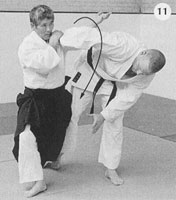

Photos 11 &12: Tori bends his front knee, advances his right hip and shifts his centre of gravity to his right across Uke's front. This has the effect of bringing Uke downwards.
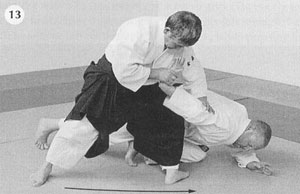 Photo 13: As Uke loses his balance, his grip on Uke's shoulder is released. Without delay Tori grips Uke's elbow, then slides his left foot towards Uke's upper body. The feeling is like that of thrusting with a spear towards Uke's armpit. Tori's left hand now grasps Uke's elbow. The action in photos 12 & 13 must be of one movement: there should be no pause in between. As Tori's left foot advances there is a moment (in between photos 12 & 13) when his knees come together before the left foot changes direction towards Uke's armpit. In other words, it moves in the shape of the letter L.
Photo 13: As Uke loses his balance, his grip on Uke's shoulder is released. Without delay Tori grips Uke's elbow, then slides his left foot towards Uke's upper body. The feeling is like that of thrusting with a spear towards Uke's armpit. Tori's left hand now grasps Uke's elbow. The action in photos 12 & 13 must be of one movement: there should be no pause in between. As Tori's left foot advances there is a moment (in between photos 12 & 13) when his knees come together before the left foot changes direction towards Uke's armpit. In other words, it moves in the shape of the letter L.
 Photos 14 - 16: Tori places his left knee on the tatami near Uke's armpit, then rocks on his left knee bringing his right knee together with Uke's left arm down to the tatami. If we now review the movements of Tori from the beginning (photo 8), he moves left-right, left-right.
Photos 14 - 16: Tori places his left knee on the tatami near Uke's armpit, then rocks on his left knee bringing his right knee together with Uke's left arm down to the tatami. If we now review the movements of Tori from the beginning (photo 8), he moves left-right, left-right.
Tori finishes in a very solid, square-like posture. His two knees and his ankles placed together make a triangle or tripod. He is sitting in kiza (up on his toes), settling down on Uke's right arm, with his back straight. There is a rounded feeling in his arms similar to the final stage of the suwari-waza kokyu-ho exercise. To apply the final pin rotate your partner's wrist strongly forwards while at the same time applying pressure with your hands as though bringing the index fingers of each hand together in a triangle shape. The heel of your left hand is bearing down on your partner's arm just above his elbow.
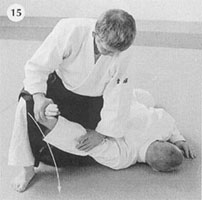
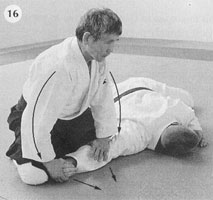

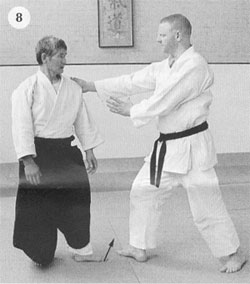
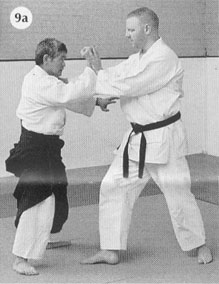
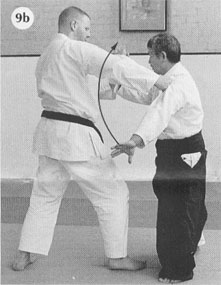


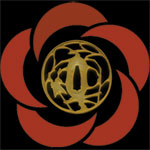

 Photo 1: Both Tori and Uke start in seiza, Uke grasps Tori's left shoulder (with a view to controlling and attacking Tori) and is ready to pull (hence the omote version of this technique).
Photo 1: Both Tori and Uke start in seiza, Uke grasps Tori's left shoulder (with a view to controlling and attacking Tori) and is ready to pull (hence the omote version of this technique).






 Photo 6: As Uke is brought down to the tatami, his grip on Tori's shoulder is relaxed. Now Tori grasps Uke's arm just above the elbow in the usual ikkyo manner. He is still holding Uke's right hand with the original nikyo grip. Tori slides his left knee towards Uke's armpit.
Photo 6: As Uke is brought down to the tatami, his grip on Tori's shoulder is relaxed. Now Tori grasps Uke's arm just above the elbow in the usual ikkyo manner. He is still holding Uke's right hand with the original nikyo grip. Tori slides his left knee towards Uke's armpit. Photo 7: Tori finishes the technique in the same manner as with omote shomen-uchi ikkyo (from kosa-dori / ai-hanmi katate-dori). He moves Uke's arm to an angle of more than 90° from his body, ideally about 100-105°. Tori is silting up on his toes (in kiza), inclining slightly forwards, his back straight and his eyes looking towards the tatami several feet beyond Uke. His two knees and his ankles (drawn together) make a very solid triangle. With his right knee placed on the inside of his right wrist and his left knee close to Uke's armpit, his knees have a feeling of expanding in both directions. With relaxed shoulders and arms he shifts his weight, with a rocking feeling, onto Uke's elbow. This is essentially the same as the finish of the suwari-waza kokyu-ho exercise.
Photo 7: Tori finishes the technique in the same manner as with omote shomen-uchi ikkyo (from kosa-dori / ai-hanmi katate-dori). He moves Uke's arm to an angle of more than 90° from his body, ideally about 100-105°. Tori is silting up on his toes (in kiza), inclining slightly forwards, his back straight and his eyes looking towards the tatami several feet beyond Uke. His two knees and his ankles (drawn together) make a very solid triangle. With his right knee placed on the inside of his right wrist and his left knee close to Uke's armpit, his knees have a feeling of expanding in both directions. With relaxed shoulders and arms he shifts his weight, with a rocking feeling, onto Uke's elbow. This is essentially the same as the finish of the suwari-waza kokyu-ho exercise. Photo 10: As Tori brings up his te-gatana to Uke's elbow, he lowers his centre of gravity and brings it strongly over his back (left) foot, (Again, don't grip your partner's elbow). Slash upwards with your te-gatana making contact with the part of your arm just below your wrist and keep your hand open and dynamic. The action is rather like that of sawing upwards against your partner's upper arm. Don't try to grip or lift your partner's arm, and don't try to take your partner's arm from your shoulder. (Use your shoulder to control your partner's action,) This action makes Uke's elbow rise and unbalances him. Tori clamps Uke's right list against his shoulder (at a point between his collar-bone and ribs) with the same grip as in kata-dori nikyo: thumb on thumb.
Photo 10: As Tori brings up his te-gatana to Uke's elbow, he lowers his centre of gravity and brings it strongly over his back (left) foot, (Again, don't grip your partner's elbow). Slash upwards with your te-gatana making contact with the part of your arm just below your wrist and keep your hand open and dynamic. The action is rather like that of sawing upwards against your partner's upper arm. Don't try to grip or lift your partner's arm, and don't try to take your partner's arm from your shoulder. (Use your shoulder to control your partner's action,) This action makes Uke's elbow rise and unbalances him. Tori clamps Uke's right list against his shoulder (at a point between his collar-bone and ribs) with the same grip as in kata-dori nikyo: thumb on thumb.

 Photo 13: As Uke loses his balance, his grip on Uke's shoulder is released. Without delay Tori grips Uke's elbow, then slides his left foot towards Uke's upper body. The feeling is like that of thrusting with a spear towards Uke's armpit. Tori's left hand now grasps Uke's elbow. The action in photos 12 & 13 must be of one movement: there should be no pause in between. As Tori's left foot advances there is a moment (in between photos 12 & 13) when his knees come together before the left foot changes direction towards Uke's armpit. In other words, it moves in the shape of the letter L.
Photo 13: As Uke loses his balance, his grip on Uke's shoulder is released. Without delay Tori grips Uke's elbow, then slides his left foot towards Uke's upper body. The feeling is like that of thrusting with a spear towards Uke's armpit. Tori's left hand now grasps Uke's elbow. The action in photos 12 & 13 must be of one movement: there should be no pause in between. As Tori's left foot advances there is a moment (in between photos 12 & 13) when his knees come together before the left foot changes direction towards Uke's armpit. In other words, it moves in the shape of the letter L. Photos 14 - 16: Tori places his left knee on the tatami near Uke's armpit, then rocks on his left knee bringing his right knee together with Uke's left arm down to the tatami. If we now review the movements of Tori from the beginning (photo 8), he moves left-right, left-right.
Photos 14 - 16: Tori places his left knee on the tatami near Uke's armpit, then rocks on his left knee bringing his right knee together with Uke's left arm down to the tatami. If we now review the movements of Tori from the beginning (photo 8), he moves left-right, left-right.